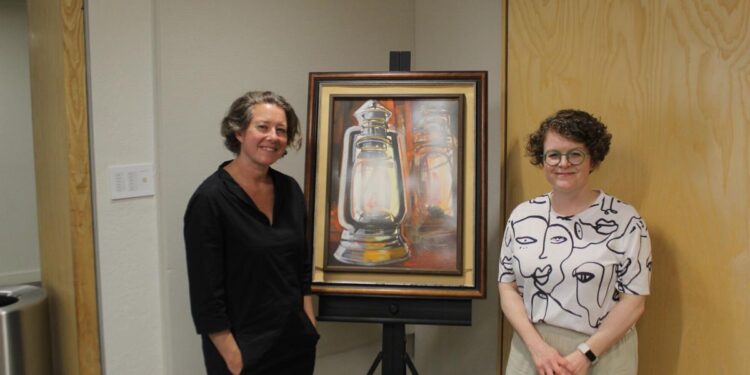Two scholars came to Lawton this week to find works by late modern artist Gebre Kristos Desta.
After talking with Jason Poudrier, Arts & Humanities Administrator with the City of Lawton, he showed them a binder with multiple works by unnamed artists. Not finding what they were looking for, they asked if he had any other paintings. Poudrier then went to an office, found the painting and they confirmed it was Kristos’s.
Kate Cowcher, Art History Lecturer at the University of St. Andrews, said Kristos was a renowned Ethiopian painter.
“He would be considered the most, if not one of the most, important modern artists in 20th century Ethiopia,” Cowcher said. “He trained in West Germany in the 1950s. He was most famous in the 1960s in the capital of Ethiopia, where he was at the heart of an incredibly vibrant creative scene.”
Cowcher said the capital had flourishing art, theater and music in the 1960s. Kristos was one of those who contributed.
“Ethiopia had a revolution in 1974,” Cowcher said. “That change of regime had a very significant impact on artists. Kristos tried to live in Ethiopia after the revolution but the revolution became a violent and oppressive regime. He escapes Ethiopia and he comes to Lawton in 1980 as a refugee. “
Cowcher said he’d been on a journey for about a year and a half.
“He’d been to West Germany, hoping to stay there, he didn’t get refugee status there,” Cowcher said. “But at a Catholic Charity at the Blessed Sacrament Church, a Catholic priest called Rev. Elmer Robnett sponsored Kristos for a refugee visa.”
Cowcher said most of the stories of Kristos’ life don’t say much about him being in Oklahoma because he died 11 months after arriving in Oklahoma City.
“Lawton is seen as a very small part in what was a much bigger career in Ethiopia,” Cowcher said. “It was generally understood as a tragic time for him because he’s in exile, he’s had to leave his country as a refugee.”
The untitled painting portrays a shining oil lamp with a red background. To the right, it shows an abstract replica of the lamp, also veiled in light.
Cowcher said Kristos may have painted an oil lamp because he had a sort of hopefulness, a “shining light” depicted by the lamp. He made the painting in Lawton, possibly between April and September of 1980.
“It’s a really interesting painting because it shows the artist’s very diverse skills,” Cowcher said. “A lot of his work, especially in Ethiopia, was extremely abstract and very expressive and didn’t really depict anything in particular. He was doing more figurative work where we can discern a person or a thing. But this painting seems to combine both of those which makes it a really remarkable painting to find.”
Cowcher said Kristos’ last known artwork was a mural at Eisenhower High School.
“It was painted by a group of students that Kristos was working with, including a man named Bobby Blackburn,” Cowcher said. “Bobby and his friends completed the mural in the artist’s honor because Kristos died in the middle of the mural being painted.”
Cowcher said unfortunately the mural has been recently painted over.
“That mural, technically, would’ve been his last work, because he was working on that, literally, as he died,” Cowcher said.
Cowcher said until Monday they didn’t know if there were any artworks by him in Lawton.
“The sense was, there would surely be something in a collection somewhere,” Cowcher said. “The exhibition that he had in 1980 had 47 artworks in it. It seems likely that some would have ended up somewhere.”
Cowcher said the painting was found in the Arts & Humanities office. As of today, this is the last known artwork by this artist.
“As soon as we had worked out it was him, we phoned friends in Ethiopia and they were able to confirm that it was definitely him,” Cowcher said.
Cowcher said in Addis Ababa, there is a whole museum dedicated to Kristos, the Gebre Kristos Desta Center.
“It has many artworks, most of which were left behind when he went into exile and most of which are much bigger,” Cowcher said. “There is one artwork by him in Ohio [but] the vast majority of his work is in Ethiopia.”
Cowcher said some of his works are depictions of abstract TVs.
“This idea of seeing through questions of vision,” Cowcher said. “It strikes me that he is here in exile and he’s still interested in the idea of illumination. But that has taken on a much more profound resonance, having experienced what is political exile from his country.”
Cowcher said he was a very versatile artist.
“His first passion was abstract painting,” Cowcher said. “He trained in West Germany, in Cologne, in the late 1950s, early 1960s. At that time, Cologne was a major center for big, expressive, abstract painting. Trying to paint things that don’t look anything like the world in which we live. That may express all manner of feelings and colors.”
Cowcher said Kristos was so affected by his time in Cologne that when he came back to Ethiopia in the 1960s, most of his works were abstract.
Cowcher said Kristos was also an art teacher in Ethiopia.
“One of the things that he taught lessons in was still life painting,” Cowcher said. “He would have students arrange objects in different ways and then depict them in ways that were not just photographic representations of what they were seeing, but trying to capture a bit of the essence of them.”
Jim Whiteley, collections manager at the Museum of the Great Plains, said the artwork will stay in the city’s collection.
“They’re trying to get it in to more public buildings throughout the city,” Whiteley said.
Cowcher said they’re working with colleagues at OU to celebrate Kristos’ legacy in Oklahoma.
Want to reach a local audience and grow your business?
Our website is the perfect platform to connect with engaged readers in your local area.
Whether you're looking for banner ads, sponsored content, or custom promotions, we can tailor a package to meet your needs.
Contact us today to learn more about advertising opportunities!
CONTACT US NOW




